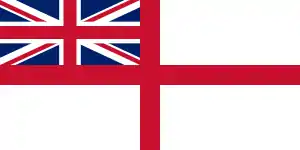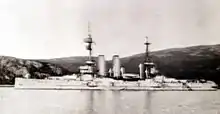British North Russia Squadron
The British North Russia Squadron was a squadron of the Royal Navy based at Murmansk from 1917 to 1919.[1][2]
| British North Russia Squadron | |
|---|---|
 | |
| Active | 1917–1919 |
| Country | United Kingdom |
| Allegiance | British Empire |
| Branch | Royal Navy |
| Commanders | |
| Notable commanders | Thomas Kemp |
History

The squadron was formed as part of an initiative by the Entente Powers to keep the Russian Empire in the First World War. One goal was to protect the large stockpiles of Allied material that had begun stockpiling at the ice-free port at Murmansk. Russia's continued involvement in the war was challenged externally by German advances into the East and internally by a strong antipathy to the war amongst the Russian population. This later factor had led to support for the Bolshevik Revolution and had resulted in the Russian Civil War. The squadron would remain in Russia throughout most of the Allied North Russia Intervention, though it served no real role in this.[2] The squadron returned to England in September 1919, shortly after the ratification of peace with Germany, with the signing of the Treaty of Versailles.
The squadron was originally placed under the command of Rear Admiral Thomas Kemp with HMS Glory as his flagship. This battleship had been refitted, with some guns being removed to allow for more accommodation for marines. There was also a depot ship, an armed boarding vessel and a variety of trawlers and drifters which had been converted to function as minesweepers.[2]
Admirals commanding
Post holders included:[3]
| Rank | Flag | Name | Term | |
|---|---|---|---|---|
| Rear-Admiral-in-Charge, Murmansk | ||||
| 1 | Rear-Admiral | Thomas W. Kemp | ||
References
- Burt, R. A. (2013). "Acknowledgements". British Battleships 1889-1904: New Revised Edition. Seaforth Publishing. ISBN 9781473826953.
- Clifford Kinvig (November 23, 2007), Churchill's Crusade, Hambledon & London, ISBN 9781847250216, OCLC 747256147, OL 9819337M, 1847250211
- Harley, Simon; Lovell, Tony. "Thomas Webster Kemp - The Dreadnought Project". www.dreadnoughtproject.org. Harley and Lovell, 7 October 2017. Retrieved 25 March 2018.